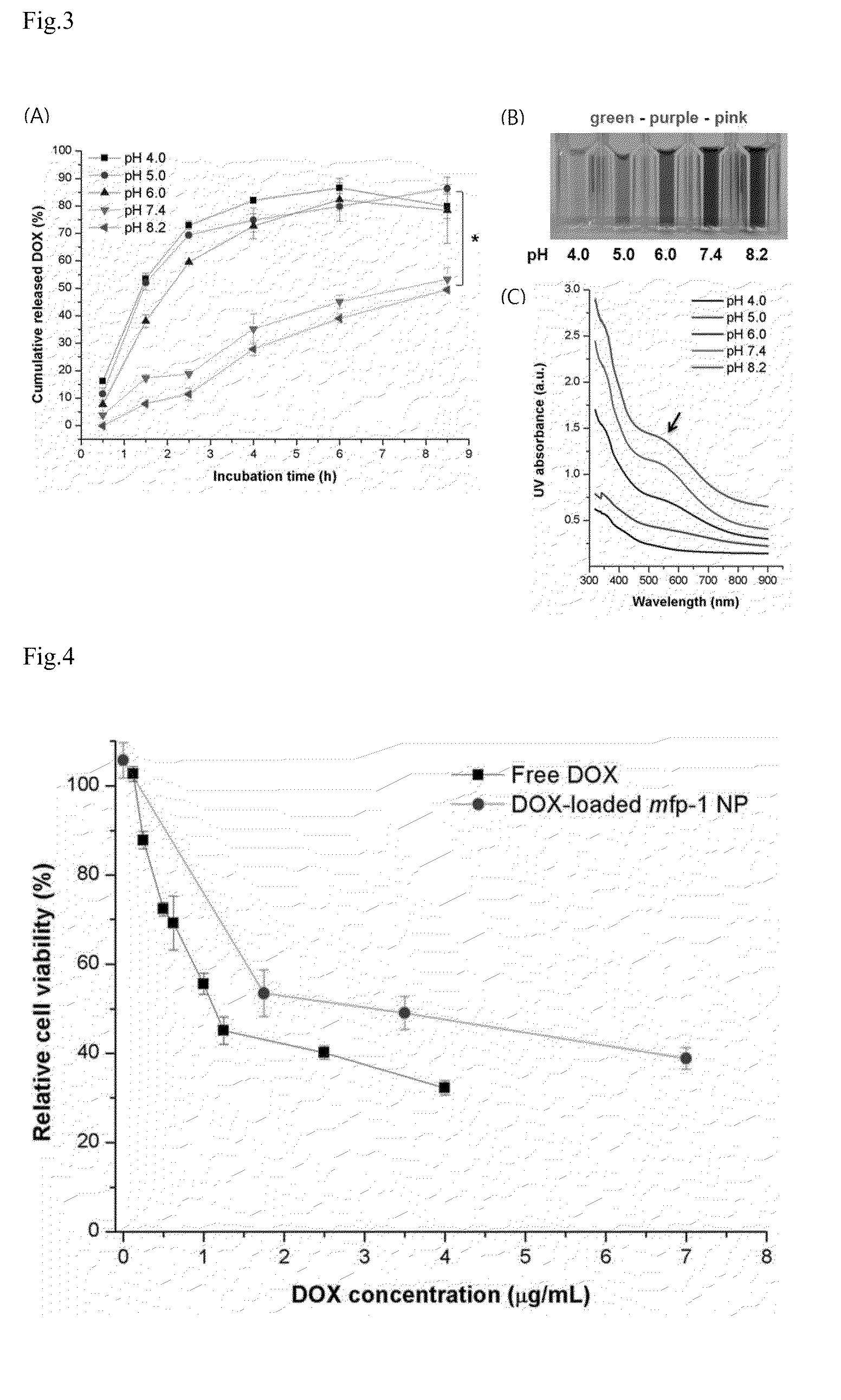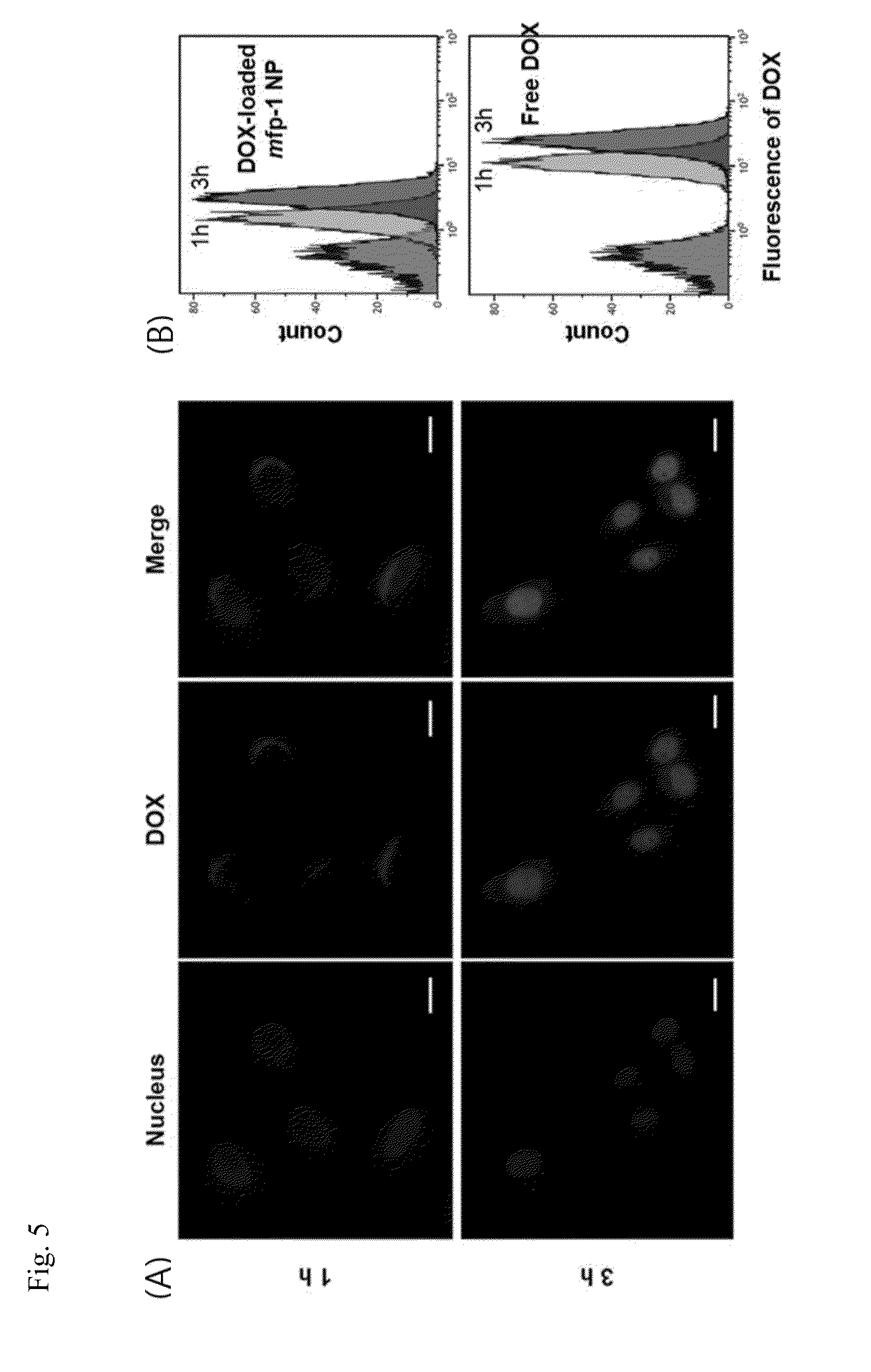Ph-responsive nanoparticle using mussel adhesive protein for drug delivery and method for preparing the same
a technology of adhesive protein and nanoparticles, which is applied in the direction of capsule delivery, peptide/protein ingredients, saccharide peptide ingredients, etc., can solve the problem that nanoparticles have not been applied to perform environmentally sensitive drug delivery, and achieve the effects of reducing the toxic effect of solvents, improving the evaporative properties of water-based solvents, and simple equipmen
- Summary
- Abstract
- Description
- Claims
- Application Information
AI Technical Summary
Benefits of technology
Problems solved by technology
Method used
Image
Examples
example 1
Preparation of Doxorubicin (DOX)-Loaded Fe(β)-DOPA Complex Nanoparticles
1.1 Preparation of DOPA-Modified Recombinant Mussel Adhesive Protein (mfp-1)
[0043]Mussel adhesive protein fp-1 (Mytilus mussel foot protein type 1) variant composed of 12 times repeated decapeptides (AKPSYPPTYK) was prepared according to a known process (see Proc. Natl. Acad. Sci. USA 2010, 107, 12850-3). Thereafter, in vitro enzymatic reaction using mushroom tyrosinase (SIGMA) was performed to convert tyrosine residues of the fp-1 variant into dihydroxyphenylalanine (DOPA). Specifically, 1.50 mg / mL of fp-1 variant solution and 100 μg / mL of tyrosinase were reacted in a buffer solution (100 mN of sodium phosphate, 20 mM of boric acid, and 25 mM of ascorbic acid; pH 6.8) for 1 hour, and dialyzed with 1% acetic acid.
[0044]Thereafter, in order to analyze modification efficiency of the mussel adhesive protein fp-1 variant, the amino acid composition was analyzed. As a result, it was identified that about 30% of the t...
experiment example 1
Analysis on Properties of DOX-Loaded Fe(III)-DOPA Complex Nanoparticles
1.1 Analysis Method
[0048]DOX loading efficiency was calculated based on the amount of DOX measured from a solution containing un-loaded DOX by dialysis and the total amount of initial DOX. Also, in order to analyze the amount of DOX loaded in the complex nanoparticles, a reference curve was obtained using free-state DOX, and then fluorescence intensity was measured with a fluorescence spectrometer (Perkin Elmer, USA) with excitation and emission filter set as 450 nm and 590 nm.
[0049]To measure particle size and polydispersity index, dynamic light scattering (DLS; Zetasizer, UK) equipment was used. The concentration of mfp-1 nanoparticles in suspension was 1 mg / mL or less and all measurements were carried out at room temperature.
[0050]The morphology of electrosprayed nanoparticles was observed by scanning electron microscopy (SEM; JSM-7401F; JEOL, Japan) and transmission electron microscopy (TEM; JEM-2100F; JEOL)....
experiment example 2
Analysis on DOX Release of DOX-Loaded mfp-1 Complex Nanoparticles
2.1 Analysis Method
[0056]DOX release from mfp-1 complex nanoparticles was evaluated in vitro under different pH environments. 1 mL of solution in PBS containing electrosprayed mfp-1 complex nanoparticles was tubed in the dialysis membrane (MWCO 3500) and incubated in 10 mL of each buffer solution with different pH by shaking at 37° C. At determined time period, 1 mL of each solution was sampled and fresh buffer was replaced. The amount of released DOX was measured by a fluorescence spectrometer. To identify presence of Fe(III)-DOPA complexes in each solution, resulting solutions after release test were collected and absorbance spectrum was analyzed using UV-visible spectrophotometer (Shimadzu, Japan).
2.2 Analysis Result
[0057]FIGS. 3(A) and 3(B) illustrate in vitro DOX release profiles and color detection of DOX-loaded mfp-1 complex nanoparticles according to pH. FIG. 3(C) illustrates UV absorbance spectrum of DOX-loade...
PUM
| Property | Measurement | Unit |
|---|---|---|
| pH | aaaaa | aaaaa |
| diameter | aaaaa | aaaaa |
| pH | aaaaa | aaaaa |
Abstract
Description
Claims
Application Information
 Login to View More
Login to View More - R&D
- Intellectual Property
- Life Sciences
- Materials
- Tech Scout
- Unparalleled Data Quality
- Higher Quality Content
- 60% Fewer Hallucinations
Browse by: Latest US Patents, China's latest patents, Technical Efficacy Thesaurus, Application Domain, Technology Topic, Popular Technical Reports.
© 2025 PatSnap. All rights reserved.Legal|Privacy policy|Modern Slavery Act Transparency Statement|Sitemap|About US| Contact US: help@patsnap.com



